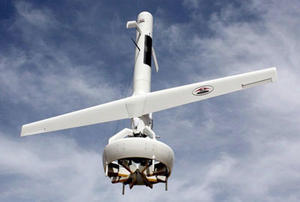In the trenchesDARPA looking for VTOL UAV to plant covert spy devices
The Pentagon is looking for a VTOL (vertical take-off and landing) UAV/UASs - or V-Bat - which will autonomously plant such surveillance devices as remote cameras/bugs, communications relays, marker beacons, small battery powered ground-crawler, or inside-buildings flying robots

The V-bat during testing // Source: spyplanes.com
DARPA, the Pentagon’s research arm, has handed out $369,677 for the purpose of “Covert Precision Emplacement of Small Payloads” from the “V-Bat Aircraft,” according to documentation issued last Friday.
The V-Bat is the vertical-takeoff version of the Bat — a series of small unmanned aircraft produced by Mountain View, California-based MLB Co. A V-Bat assembled for flight has a wingspan of 10 feet, weighs 70 lb, and can fly for up to 5 hours on a fill of two-stroke juice. According to the company brochure it takes off and lands in tailsitter mode, and can tip over into winged flight to travel at up to 110 knots — almost 140 mph.
Lewis Page writes that the V-Bat can be fitted with a variety of spyeye-type payloads and will lift off, fly about, and land again all autonomously — there is no need to control it in flight, just to tell it where to go on a GUI map control system.
Page notes that so far there is nothing exceptional here, as there are plenty of other UAV/UASs of similar capability out there for the price of about $100,000.
Where DARPA come in is the covert placement of small payloads, which makes it more interesting. A V-Bat might drop down out of the sky to plant such things as remote cameras/bugs, communications relays, marker beacons, small battery powered ground-crawler, or inside-buildings flybots, etc. The V-Bat’s payload is listed as 5 lb, but presumably might squeeze in a pound or two more by sacrificing fuel.
One might have thought this sort of device to be in service with the U.S. military already, Page notes, but evidently it is not or DARPA would not be looking into it. The lack of such capability is probably accounted for by the fact that as yet VTOL (vertical take-off and landing) UAV/UASs are still quite rare.
This is a DARPA-funded project, but this does not mean that the project pushed the edge of science. Similar feats have already been demonstrated by full-sized unmanned or optionally manned supply helicopters.
